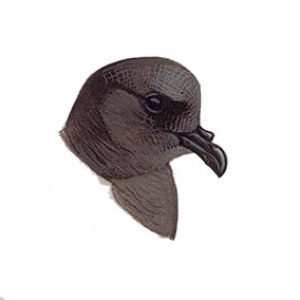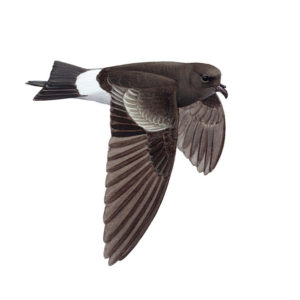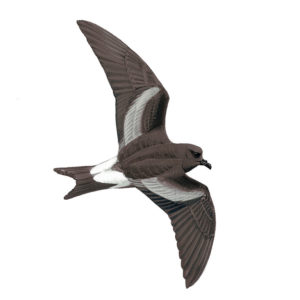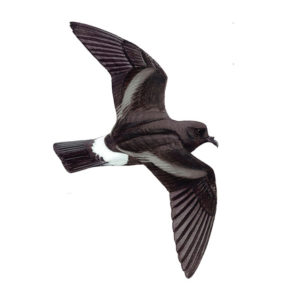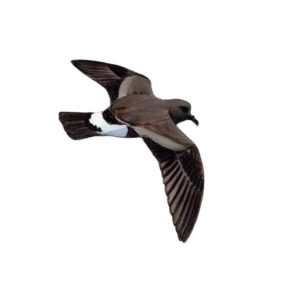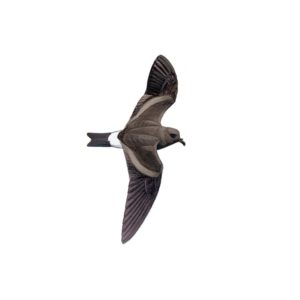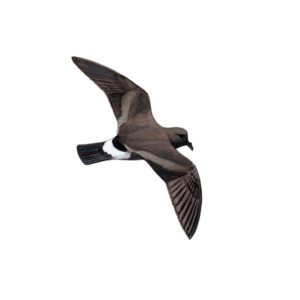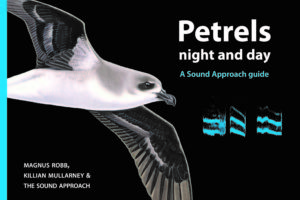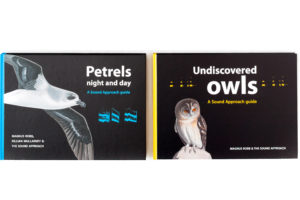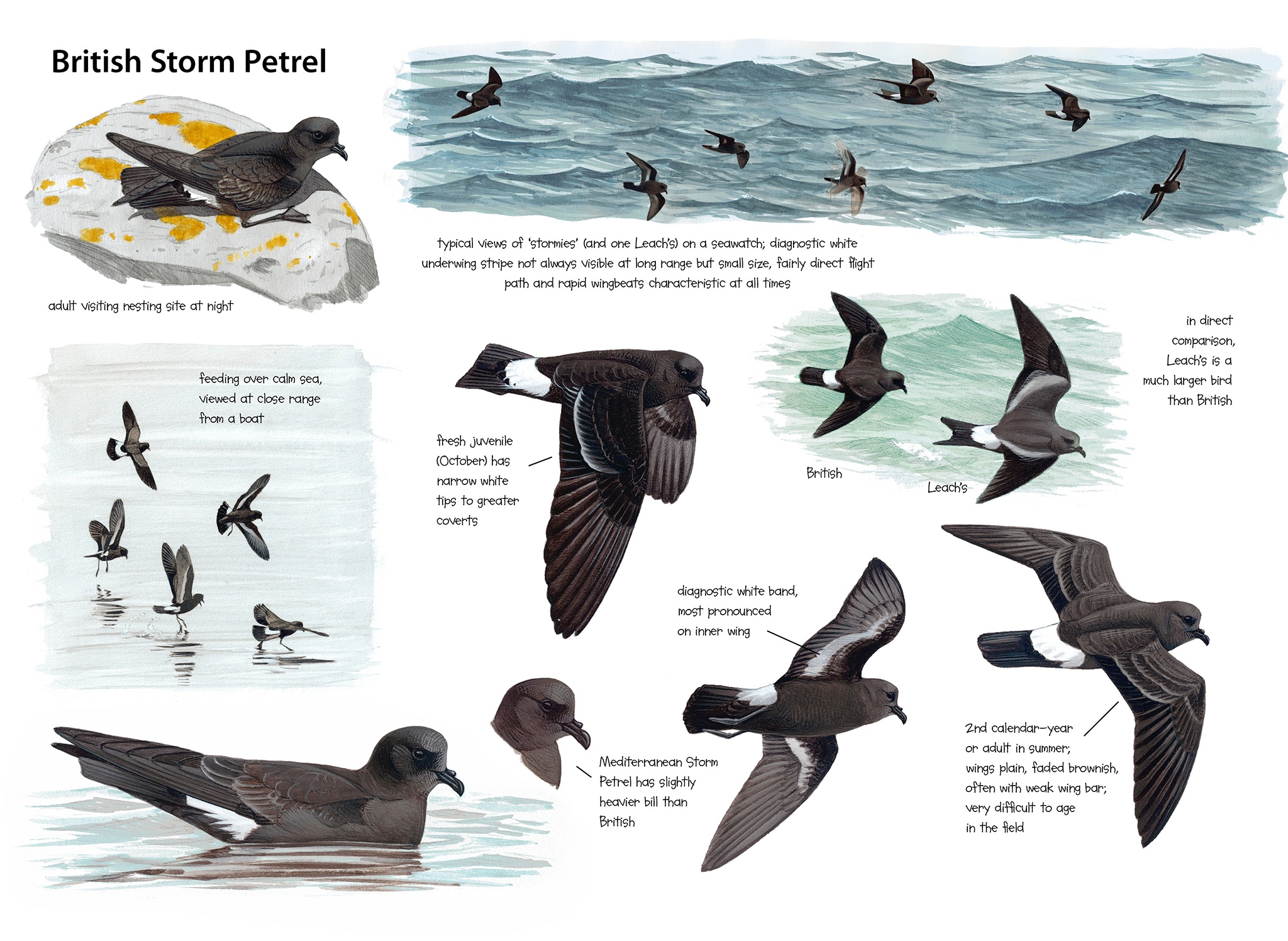
Killian Mullarney
Text by Magnus Robb.
A great pyramid of jagged rock and slippery green slopes, Skellig Michael is one of the wildest isles off the Irish coast. Whatever loose rocks it once had were used to build the monastery on its crown, back in the seventh century. The monks are long gone now, and Skellig Michael has become a World Heritage Site. But saints and virgins still dwell in its dry stone walls.
Visitors climbing the 600 or so steps of Skellig Michael’s ‘stairway to heaven’ may become aware of a strange, slightly sweet, musky scent. Beneath the steps, and in all the walls of the monastery, 10 000 pairs of British Storm Petrels Hydrobates pelagicus are raising their young. Their traditional name ‘stormy petrel’ is derived from an apparent ability to walk on the surface of the sea, like St Peter, while hanging effortlessly in the wind. Their scientific name, Hydrobates or ‘water walker’ refers to the same feat. Ancient mariners knew them as ‘Mother Carey’s chickens’, a name probably derived from Mater Cara (‘Mother Beloved’): “when these little birds appeared beside a ship before a severe storm began it was regarded as a signal to the faithful that the Virgin Mary, while warning them to prepare for the gale, would answer their prayers with her protection and care” (Lockley 1983). Others said Mother Carey was a satanic sea-witch, who possessed the key to Davy Jones’s locker, the deep sea mortuary of the drowned. Her ‘chickens’ flocked around ships in bad weather, waiting for new recruits, the lost souls of pirates and mutineers, destined to wander the seas for eternity.
In late August 2006, as I sat below the ruins of the monastery, young British Storm Petrels were calling in their nests, some still two months away from fledging. At the same time, I could hear adults fluttering past in the dark. Storm petrel traffic was becoming congested on the approach to the ancient monument. This was not my first visit to a Hydrobates colony. I had already recorded the basic repertoire in Shetland and Iceland, and on Benidorm island in the Spanish Mediterranean. Everything I had heard on these other occasions came from inside a wall or under a rock. In Spain, storm petrel expert Eduardo Mínguez told me his birds call only in their burrows, and a paper by James & Robertson (1985d) lists British Storm Petrel as one of several species, including Bulwer’s Petrel Bulweria bulwerii and White-faced Storm Petrel Pelagodroma marina, that remain silent in flight. While preparing for the Skellig Michael trip, however, I read convincing and evocative descriptions of display flights with calling, written by an earlier generation of storm petrel fanatics (Davis 1957, Lockley 1983). Now I had three nights to spend in a large colony, an ideal opportunity to check this out for myself.
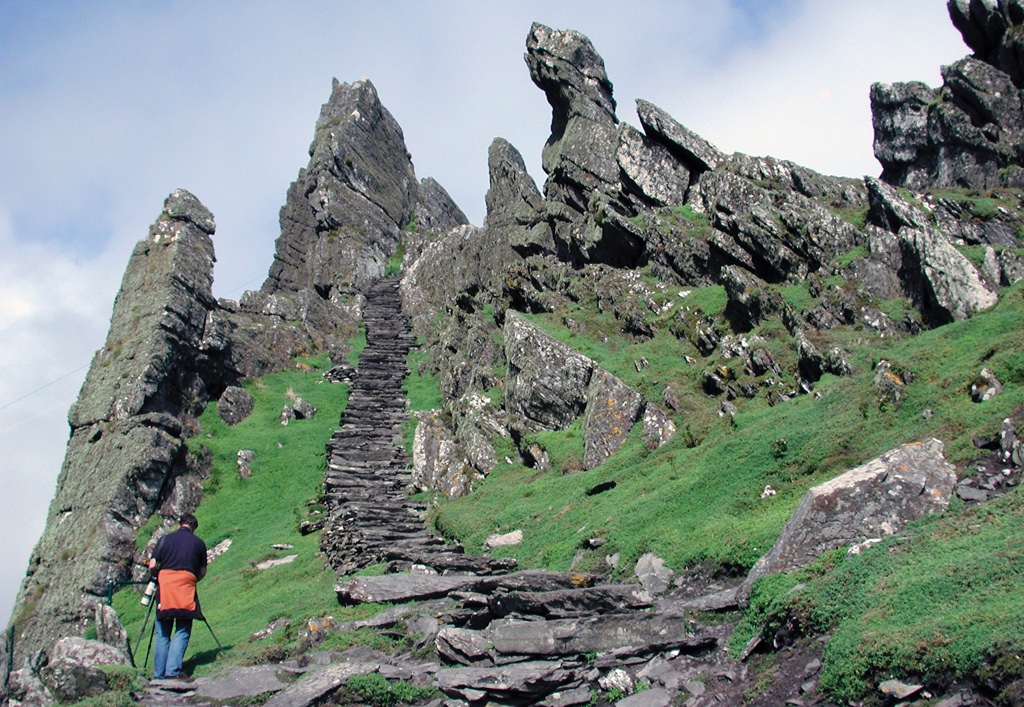
‘Stairway to heaven’ near top of Skellig Michael, Kerry, Ireland, 25 August 2006 (Pim Wolf). British Storm Petrels Hydrobates pelagicus breed under the steps.
After several fruitless sessions, hearing only storm petrel wingbeats, I found something more promising. Two or three British Storm Petrels were flitting to and fro over a certain stone step that seemed to be exerting a magnetic attraction. For some reason, they were reluctant to actually land there. I set up my microphones on the very spot, moved back 10 m and put on my headphones. At first all I could hear was the sea about 150 m down below, and some high-pitched begging calls of a nearby nestling. I soon started hearing a familiar call, accompanied by wingbeats, moving around in my stereo headphones (CD2-12). I had heard the same call from storm petrels in their burrows, many times before. Over the course of the next couple of nights, I often heard series of these weak calls in flight, usually in the same small area on the margins of the colony. They were never terribly conspicuous.
The night when I recorded CD2-12 was gloomy and overcast, just a few days after the late August new moon, so little of the storm petrels’ behaviour was visible. Peter Davis (1957) enjoyed better views in moonlight. While working as a warden on Skokholm, he watched display flights in late May, June and early July:
“This flight may take place at any hour of the night, and occurs in a fairly limited area above the burrow, where it probably begins and ends. One bird closely pursues the other, often within six inches of its tail, and the flight is more rapid and direct than in the normal fluttering, erratic action. The course followed is often roughly circular, more often extremely irregular. At times the birds part, together forming a figure of eight, and resume the chase when they meet in the centre. A loud call which I write as “terr-chick” is given at intervals, and becomes louder and more frequent as the excitement mounts, particularly if a third bird joins in, as sometimes happens…” (Davis 1957).
CD2-12: British Storm Petrel Hydrobates pelagicus Skellig Michael, Kerry, Ireland, 22:28, 27 August 2006. Chatter calls of two or three individuals in flight. Background: rhythmic calls of a nestling. 060827.MR.222835.21
Since Davis wrote this, the calls he described have usually been referred to as ‘flight calls’. A logical name, you might think, but actually they are used far more often when British Storm Petrels have their feet on the ground. Besides, they are not the only calls British use in flight. My preferred name for them is ‘chatter calls’, because they are equivalent to the more obviously chattering ‘chatter calls’ of, for example, Leach’s Oceanodroma leucorhoa and Madeiran Storm Petrels O castro. Other sounds Davis heard in flight included:
“…Snatches of the purring song are given, and several variations of the “terr-chick” call, with the syllables transposed or the first one omitted. There is also a very rapid “wick-wick-wick” which I have heard very rarely” (Davis 1957).
“Snatches of the purring song” were something I heard quite often during the display flights I witnessed on Skellig Michael. The purring sound is given in short bursts, separated by a strange little breath note, once famously likened to “a fairy being sick” (C Oldham in Lockley 1983). Purring is more often heard coming from the safety of a burrow, where the combined phrase of purring plus breath note is repeated monotonously, often for minutes on end. The less common flight variant has shorter phrases, of which there are typically just three and seldom more than five. In CD2-13, you can hear what happens when a storm petrel flying from a burrow gives a short snatch of aerial purring as it flutters past its neighbours on the way out. In no time, a ripple of purring spreads through the walls of the monastery. Other storm petrels fly past without calling, at 0:12 and 0:19.
CD2-13: British Storm Petrel Hydrobates pelagicus Skellig Michael, Kerry, Ireland, 22:47, 26 August 2006. Aerial purring song, given by a male leaving a burrow. It triggers a chorus of purring songs from other males in neighbouring crevices. Background: rhythmic calls of a nestling. 060826.MR.224721.00

‘Beehive’ cells in monastery of Skellig Michael, Kerry, Ireland, 25 August 2006 (Pim Wolf). The British Storm Petrel Hydrobates pelagicus in CD2-13 took off from the left wall of the nearer beehive cell.
In CD2-14, you can hear another recording of purring calls in flight, this time by a bird circling above a spot where a male is also purring from underneath a stone step. Note how much faster the purring of the flying bird sounds compared with the one hidden away in its burrow, due to the former’s shorter phrases. This is a consistent feature of aerial purring.
CD2-14: British Storm Petrel Hydrobates pelagicus Skellig Michael, Kerry, Ireland, 01:43, 27 August 2006. Aerial purring song in display flight. Another male purrs from a nearby burrow. 060827.MR.14347.00
I did not hear the rapid wick-wick-wick mentioned by Davis while I was on Skellig Michael, but I have recorded it in a colony in Iceland. In CD2-15, you can hear a British Storm Petrel giving this call as it flies past in the darkness, over a background of countless Atlantic Puffin Fratercula arctica and Leach’s Storm Petrel wings.
CD2-15: British Storm Petrel Hydrobates pelagicus Elliðaey, Vestmannaeyjar, Iceland, 00:30, 19 July 2003. Rapidly repeated, almost snipe-like wick-wick-wick calls in flight. Background: wingbeats and a few calls of countless Atlantic Puffins Fratercula arctica and Leach’s Storm Petrels Oceanodroma leucorhoa. 03.033.MR.11125.22
Although Davis, Lockley and others did a great deal of work on the breeding biology of British Storm Petrels, it was not until the early 1980s that Paul James shed some light on the behavioural significance of their calls. Through playback tests on birds of known sex, James (1984a) discovered that chatter calls are given by both sexes, while purring is an exclusively male call, its main purpose being to advertise the male’s presence and his possession of a burrow.
In British Storm Petrel, chatter calls typically have three clearly separate parts – short, long, short – that can be transcribed as m-Terrr-chik. The initial, low-pitched m– note is always quiet, and may be extremely brief or missing altogether. It is easy to miss in flight, when a chatter call is likely to be heard from a greater distance. The long Terrr note in the middle is strongly accented and may occasionally be doubled. At the end, the chik is loud and higher pitched than the rest of the call. Typical examples of chatter calls can be heard in CD2-16, where two birds can be heard answering each other, left and right of the microphones. In CD2-17, you can hear an example of a male sometimes doubling his Terrr notes. I found him all on its own, chattering and occasionally purring under a step on a remote stairway.
CD2-16: British Storm Petrel Hydrobates pelagicus Skellig Michael, Kerry, Ireland, 00:13, 26 August 2006. A male on the left gives chatter calls and snatches of purring song, while a possible female on the right responds with chatter calls. 060826.MR.01357.00
CD2-17: British Storm Petrel Hydrobates pelagicus Skellig Michael, Kerry, Ireland, 00:25, 26 August 2006. Chatter calls of a lone male under a stone step, some distance from the main part of the colony. Background: calls of sleepless juvenile gulls Larus. 060827.MR.04923.00
At present, it is not known how to distinguish between male and female chatter calls, although apparently females can tell the difference. In Paul James’ playback experiments with chatter calls, females responded to 43.6% of males, but only to 28.6% of females. After many nights listening to British Storm Petrel chatter calls, I still have no idea how they do this. When it comes to identifying females, all I can do is make an educated guess, based on behaviour and the absence of purring. The bird duetting with a male in CD2-16 was possibly a female, because during the half hour or so that I spent with these two birds, ‘she’ never purred. Although the male’s chatter calls sound slightly deeper, less harsh and shorter than the possible female’s, this may be nothing more than individual variation.
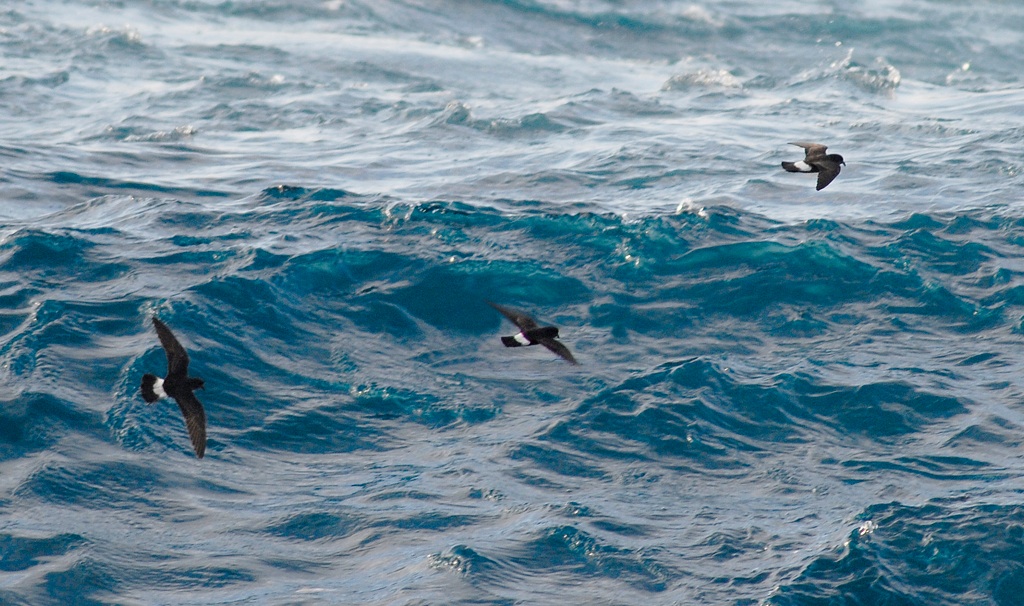
British Storm Petrels Hydrobates pelagicus, Bay of Biscay, 28 August 2007 (René Pop)
Even during the daytime, many a visitor to the monastery on Skellig Michael must have been baffled by the purring of male British Storm Petrels. This is by far the most prominent sound in the colony, and all the more so at night. At close range, purring can completely dominate the night soundscape, and from a distance, it is the breath note that draws a listener’s attention first. Just how far the sound travels depends on how deeply the bird is hidden away, and whether there are wind, surf or other petrel calls to compete with. In CD2-18, a single bird is purring at the start, then one by one, six other males join in on either side, each at a slightly different tempo. They shift in and out of phase with one another, in a constantly changing texture. The recording was made beside a two metre high wall, just outside the entrance to the monastery.
CD2-18: British Storm Petrel Hydrobates pelagicus Skellig Michael, Kerry, Ireland, 02:35, 27 August 2006. Purring song of up to seven males, in a high wall just beside the entrance to Skellig Michael’s 7th century monastery. Background: rhythmic begging calls of nestlings. 060827.MR.23503.01
One of the first storm petrel colonies I ever visited was on Mousa, Shetland. In July 2001, I joined skipper Tom Jamieson on his boat the Solan, for one of his regular night trips to the island. The main tourist attraction is the well-preserved Iron Age broch, a type of cylindrical, thick-walled stone fort found only in Scotland. Both Grey Seals Halichoerus grypus and Harbour Seals Phoca vitulina live around Mousa, and breeding birds include Common Ringed Plovers Charadrius hiaticula and Arctic Terns Sterna paradisaea. But during Tom’s night time excursions, British Storm Petrels are the stars of the show. My visit took place just three weeks after the summer solstice, so it was not until 23:15 that I started recording the petrels. Mousa is thought to have the largest colony of this species in the United Kingdom. A huge gathering of non-breeders, estimated at 123 000 birds, was once recorded here, on the night of 22/23 July 1995. The normal breeding population is estimated at ‘only’ 6800 pairs (Fowler & Hounsome 1998).
Low, dry stone dykes and the broch itself accommodate 56% of the population, while the rest breed under scree and boulder beaches (Ratcliffe et al 1998b). CD2-19 was recorded at a knee-high section of stone wall in the centre of the island. Compared to their south-west Irish counterparts, Mousa stormies purr with slightly shorter phrases, resulting in an apparently faster tempo, and their breath notes are only two thirds as long. Two decades earlier, Paul James (1985a) recorded differences along the same lines between Mousa and Puffin Island, Kerry (close to the Skelligs). Curiously, these variations seem to be of no great importance to the storm petrels themselves, at least between different Atlantic colonies. In one experiment, storm petrels on Mousa actually showed a stronger attraction to purring calls recorded on Skellig Michael, than to ones recorded in their own colony (Ratcliffe et al 1998a).
CD2-19: British Storm Petrel Hydrobates pelagicus Mousa, Shetland, Scotland, 23:18, 11 July 2001. Purring song of several males, in the walls of an Iron Age fort. 01.032.MR.11706.00
When James (1985a) discovered that there was slight geographical variation in storm petrel purring calls (but not chatter calls), he speculated that this might be due to vocal learning. In songbirds, ‘dialects’ can form when singers learn from their immediate neighbours. The result is that birds in one locality can sound almost identical, but the similarity can decrease over fairly short distances, due to a kind of ‘Chinese whispers’ effect. Intrigued about the possibility of vocal learning in British Storm Petrels, Peter Slater (1991) visited Mousa and tried to detect localised variation in purring calls within the colony. But he found no evidence that neighbours sounded more similar than storm petrels in different parts of the colony and concluded that neighbours were not learning from each other.
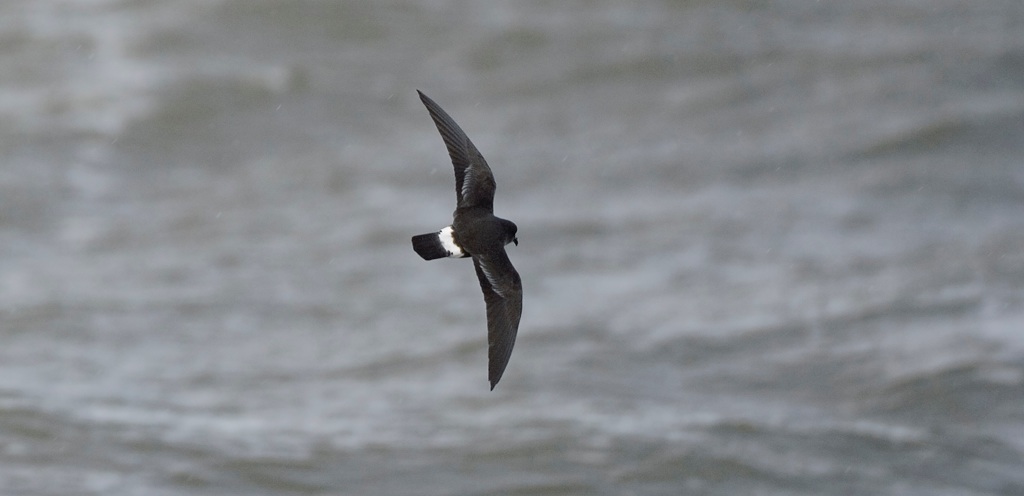
This juvenile British Storm Petrel Hydrobates pelagicus had only been flying for a few weeks at most when it was caught up in a north-westerly storm, Flevocentrale, Flevoland, Netherlands, 10 November 2007 (Mervyn Roos).
Playback of purring song has been used to great effect in breeding surveys, which are commonly conducted in daytime. Mid-July is the best time, when colony attendance by breeders is about 90% and non-breeders only account for about 15% of storm petrels present in burrows. Response rates differ between colonies, due to effects of the environment, colony location, playback equipment etc, so results need to be treated with care (Ratcliffe et al 1998a).
Recordings of purring calls are also used to great effect by ringers, and not just at breeding sites. In various European countries, hundreds of storm petrels are lured into mist nets each summer by loudspeakers blasting purring calls out to sea. In August 2002, Killian and I joined Alyn Walsh for a night’s ringing at Carnsore Point, Wexford, the south-eastern corner of Ireland. One of the storm petrels we trapped that night, an adult male, can be heard calling in the hand in CD2-20. Alyn switched off the loudspeakers and tickled the bird’s neck while I recorded its calls.
CD2-20: British Storm Petrel Hydrobates pelagicus Carnsore Point, Wexford, Ireland, 23 August 2002. Calls of an adult male in the hand, which had been tape-lured and trapped in a mist net for ringing purposes. 02.039.MR.13453.01
In July 2003, I joined a petrel ringing expedition to the Vestmannaeyjar, Iceland, to make sound recordings of Leach’s Storm Petrels. On this occasion, storm petrels (mainly Leach’s) could be trapped without the use of playback, simply because so many were present. Mist nets were set up near a ruined wall where a few British Storm Petrels were breeding, and we trapped one that was wearing a Portuguese ring. A couple of months later, when I was in Portugal, I made a few enquiries about this bird. It turned out to have been ringed as a migrant on 3 July 2002 at Ponta da Almadena near Portimão, Algarve, 3030 km to the south-west, when it was at least two years old.
There are many good stories to be told about storm petrel ringing, and two of the best I have heard are from Ireland. One night in the early 1990s, Naomi Ducksfield set up her nets on the Saltee islands, Wexford, near the south-eastern corner of the country, and trapped quite a few birds. She left for the mainland the next morning, and after a five hours’ drive along the southern coast, she arrived on Cape Clear, Cork, over 200 km to the south-west. Imagine her amazement when she trapped two of the very same storm petrels she had ringed on Great Saltee the night before! When I asked Alyn for his own best storm petrel ringing story, he told me about one he trapped on Skellig Michael in 1992, with a ring so tatty he decided to replace it with a new one. It turned out this bird had been ringed there as an adult back in 1966, when it was probably already at least in its third or fourth year. By 1993, when he recaptured it, the bird was almost certainly 30 years or older, an incredible age for a bird the size of a sparrow.
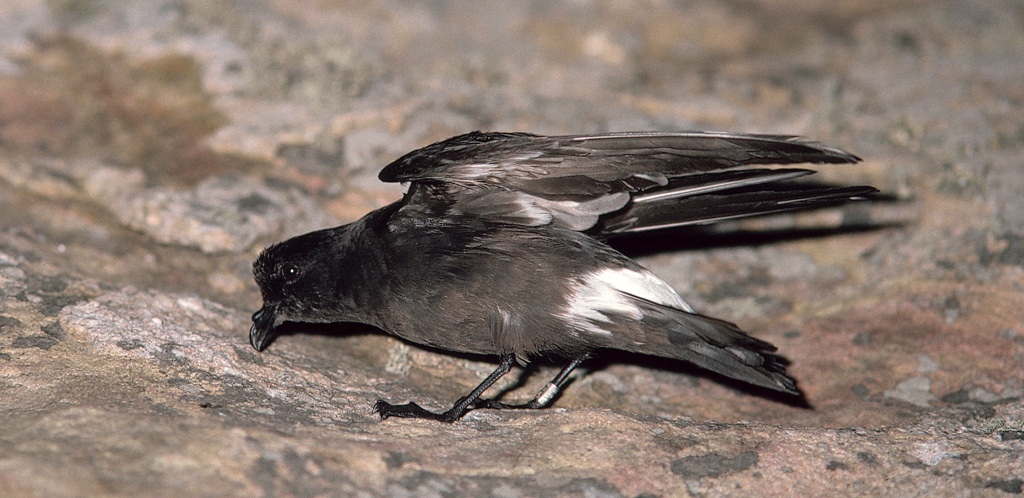
British Storm Petrel Hydrobates pelagicus, Skomer, Wales, 8 June 1988 (René Pop). This ringed individual was 33 years old at the time when the photograph was taken.
Alyn’s ringing work with storm petrels was the main reason we were granted permission to spend three nights on Skellig Michael in late August 2006. At this time of year, the colony was full of nestlings, probably averaging about three weeks old. Their weak calls could be heard throughout the night, and you can also hear them in CD2-21. The calls we heard most often were the short, rapidly repeated ‘rhythmic begging calls’ that you can hear slightly to the left. On the right, another nestling is giving ‘long begging calls’, which we heard much less often.
Begging calls of British Storm Petrel have been studied in much less detail than those of Wilson’s Storm Petrel Oceanites oceanicus. In Wilson’s, a very similar ‘long begging call’ is given in the presence of a parent, whereas ‘rhythmic calls’ tend to be given when parents are absent (Quillfeldt 2002). If the same can be said of British, then the nestling on the left in CD2-21 is probably alone, while the one on the right may be enjoying a tasty meal, served up by one of its parents.
CD2-21: British Storm Petrel Hydrobates pelagicus Skellig Michael, Kerry, Ireland, 22:26, 25 August 2006. Rhythmic begging calls of a nestling on the left, which is almost certainly alone, and long begging calls of another on the right, possibly being fed by one of its parents. In the centre, chatter calls of an adult can be heard. 060825.MR.222622.00

